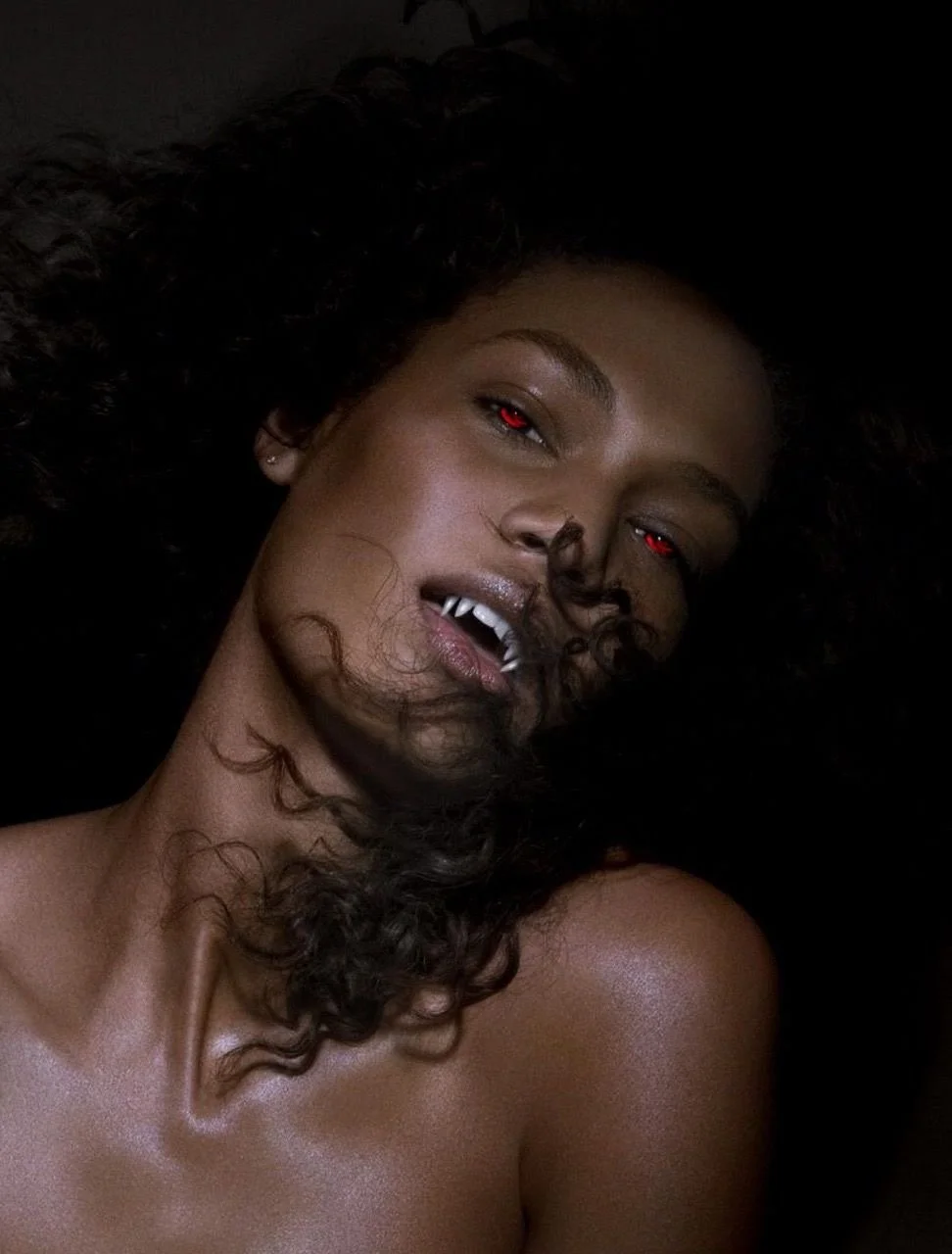Shadow Bloodlines: Black Vampires, Spirit, and the Power of the Unseen Self
Aaliyah as Akasha in Queen of the Damned (2002)
The Vampire as the Shadow
There’s something magnetic about the myth of the vampire. They are timeless, seductive, and a little tragic, forever on the edge of death and desire. For centuries, vampires have been the mirror through which culture gazes at its own fears: sex, contagion, power, and what it means to be human. But in recent years, the vampire’s reflection has shifted in terms of diversity. With Black vampires emerging across screens and pages such as Interview with a Vampire to Queen of the Damned and Lovecraft Country’s gothic reimaginings, a new bloodline of vampires have entered the myth.
These portrayals aren’t just about inclusion or representation, they’re also a form of reclamation. The Black vampire challenges the centuries old symbolism of the creature as the ultimate “Other,” transforming the monster into a mirror of empowerment, shadow work, and spiritual survival. To understand the vampire, you have to understand what they’ve always represented: our want for power, the fear of our own darkness, and the desire to live beyond the limits of what’s been imposed on us.
Psychologically, the vampire has always been the embodiment of the shadow self, a term Carl Jung used to describe the parts of us we repress, deny, or fear. The shadow is where our shame lives, where our hidden cravings, power, and pain hide. The vampire is our shadow in cinematic form: the nocturnal self that drinks what it needs without apology, that refuses death, and claims beauty even within the darkness.
For many Black audiences, this shadow symbolism hits deeper. Blackness itself has been historically cast as “the shadow” of white western consciousness, classified with traits white society feared such as sensuality, danger, rebellion, wildness. The vampire myth, built on the idea of the foreign, the “othered,” and the forbidden, has long paralleled how Blackness has been constructed in the cultural imagination.
So when Black creators step into that myth such as when Wesley Snipes strides through the night as Blade, this is a rewriting of a cultural moment. Blade’s daylight walk is symbolic, he can exist in both light and dark. He is a predator and protector, shadow and savior, representing the equal balance of both existences.
Bailey Bass as Claudia in Interview with a Vampire (AMC)
Feeding and Power
In older stories, the act of vampire feeding is a metaphor for transgression and sin in one action, embodying lust, hunger, addiction, the refusal to restrain oneself. But when viewed through a spiritual lens, the vampire’s thirst can also be seen as the human desire for energy, attention, and power, the soul’s hunger to feel alive.
In Black spiritual traditions, from Hoodoo to Yoruba cosmology, life force is sacred. Energy is transferable, and everything has spirit. The vampire’s act of feeding can be interpreted as an inverted ritual, a distorted reflection of the sacred exchange of energy. The tragedy is that the vampire feeds but never feels completely full.
This is also a reflection of our modern state of consumption. Whether it’s the endless scrolling, the constant media bombard, the longing to feel satisfied never quite arrives. In that sense, the vampire is a prophet of our times, warning us that consumption without consciousness leads only to more emptiness.
Queen of the Damned (2002)
Blackness, Beauty, and the Erotic Power of the Undead
When Aaliyah appeared as Queen Akasha in Queen of the Damned (2002), her portrayal was both haunting and divine. Draped in gold, with serpentine movements and hypnotic eyes, Aaliyah’s Akasha was the image of a Black goddess reclaiming her power, she demanded worship from all her followers within her pantheon.
Akasha’s vampirism wasn’t framed as a curse, it was seen as a form of transcendence. In her hands, vampirism became a form of liberation, a sensual, spiritual sovereignty that has been denied to many Black women. Akasha represented the power to reclaim the erotic without shame. To be powerfully desired, embodying hunger, pleasure, and mental control at once.
Vampirism and the Legacy of the Body
To talk about Black vampires is also to talk about the history of the Black body and how it’s been commodified, consumed, fetishized, and feared. Enslavement itself was a system that drained energy, labor, and identity for the survival of another. In that sense, the Black vampire myth can hold ancestral resonance. What happens when the consumed becomes the consumer, when the one who was drained becomes the one who feeds?
The answer is both liberating and unsettling. In claiming the power to feed, the Black vampire reverses the historical narrative of exploitation while also confronting the moral complexity of power itself. Power changes the one who holds it. The vampire asks what happens when the oppressed becomes powerful? Can we feed without becoming what we once despised? That’s the haunting question beneath the surface of many Black vampire stories, from Blade’s moral code to the tortured immortals of Louis and Claudia in Interview with the Vampire (AMC).
Teresa Graves as Countess Vampira
The Cultural Fear of the Dark
For all the power the Black vampire embodies, there’s also an undeniable tension within Black culture’s relationship to monsters and the occult. Many of us grew up in households where watching horror was forbidden, where talk of spirits or witchcraft was met with scripture or skepticism. The devil was very real, and playing with darkness, even in fiction, felt dangerous.
This resistance isn’t superstitious, for generations faith was a refuge against terror. When the world was monstrous towards the Black community, many turned to church as the only light to keep the mental darkness at bay. To embrace the monster could feel like a form of betrayal. It meant identifying with what you’d been taught to fear or fight against.
But monsters, especially in Black storytelling, have always been metaphors. From zombies born of Haitian folklore to the haunted legacies in Candyman, these stories are history manifesting itself wanting acknowledgment. The Black vampire continues this lineage, transforming fear into familiarity. Where older generations avoided the shadow and its work, the newer ones are saying maybe that darkness is ours to understand. That shift marks a profound spiritual evolution: from avoiding our shadow to engaging with it, from being in denial to integration. In embracing the monster, our culture is expanding its understanding of spirituality and faith. It’s recognizing that salvation might require looking directly at what we’ve been told to be afraid of.
Immortality and Ancestral Memory
Spiritually, the vampire’s immortality reflects the deep human fear of forgetting and being forgotten. To live forever sounds like a gift, but it’s also a curse of separation, existing outside time, outside community, and outside the cycle of life and death that connects us to spirit.
In African and diasporic spirituality, death isn’t an ending but a form of spiritual return. Ancestors remain present, guiding and feeding the living through memory and ritual. The vampire, however, is cut off from that lineage unable to die, to rest, forever severed from the ancestral plane. That’s what makes the Black vampire’s story unique, it can become a metaphor for the diaspora itself. A form of displacement and survival without rest, the endless search for belonging when your roots have been obscured.
To heal that spiritually means reclaiming the cycles of life and death, finding sacredness in endings as much as beginnings. The Black vampire, in its hunger for connection, becomes a mirror for the diaspora, longing to return home.
Kofi Siriboe in Doja Cat’s Streets music video
Shadow Work and Spiritual Integration
In spiritual practice, shadow work means confronting the parts of yourself you’d rather not see such as envy, rage, ego, and lust. But those parts of ourselves hold power and when you face them you’re able to integrate them. The vampire’s story is an invitation to do the same. What is this hunger trying to teach us? When we look at Black vampire characters through this lens, we see models of shadow integration. Spiritually, this is the work of alchemy turning the personal shame into power. The blood becomes a symbol of transformation, not just an expression of death.
Vampires also reveal the collective shadow of society and the fears and desires projected onto others. In Western culture, this shadow has long been racialized. Early vampire stories, such as Dracula, carried anxieties about immigration and sexuality. The vampire was always labeled as the outsider who threatened purity and order.
Black vampire stories become acts of cultural shadow healing. They bring what’s been repressed, Black power, sensuality, mysticism, into the light of mainstream myth. They ask audiences to confront their discomfort with Blackness as divine, eternal, and desirable. Every time a Black vampire graces the screen, the myth shifts and the monster becomes the mirror for what we’ve tried to hide away.
Jacob Anderson as Louis in Interview with a Vampire (AMC)
Blood Memory: The Future of the Myth
Today’s Black vampire stories are evolving beyond horror into something more metaphysical. They’re exploring immortality and what it means to carry centuries of memory in your blood. In shows like Interview with the Vampire (the AMC adaptation), actor Jacob Anderson’s portrayal of Louis adds depth to the theme of Black immortality: a man navigating both racial trauma and eternal life. His vampirism becomes a meditation on history, how trauma lingers, and how transformation can be both violent and a sacred retelling.
These stories suggest that the vampire isn’t just undead, they can become symbols of cultural memory that refuse erasure. For Black artists, that can be profoundly spiritual and symbolic.
Embracing the Dark
To love vampires is to love the dark, to see the beauty in what’s hidden, sacredness in what’s feared. Spiritually, this is the essence of shadow work and of liberation. The Black vampire teaches us that the dark is not always evil as it can be fertile, creative, and alive. Maybe that’s why the vampire keeps returning to our screens, because they remind us of something we’ve forgotten as a society. Wholeness isn’t found in the good alone, but in the union of both the shadow and the light.
The Black vampire can be more than a reimagined monster, they can also be a spiritual teacher. A reflection of our need to reclaim our shadow, honor our ancestors, and to find beauty in the parts of ourselves we’ve been told to fear. In the end, instead of choosing between the light and the dark, we only need to stop pretending that we’re not made of both.
When I first saw Aaliyah as Akasha, I didn’t have the language for what I was witnessing but I knew it was different. Here was a Black woman, powerful and sensual, existing beyond morality, without apology. Years later, I understood I was watching a mirror of our own shadow, the parts of us that want to be seen, fed, and freed.
Maybe that’s the real spell of the Black vampire. They don’t seduce us because they simply drink blood but because they remind us of our own unclaimed power as individuals and as a community. The mystery, and the depth doesn’t just exist on screen, but also within each of us and our own shadows to discover.







